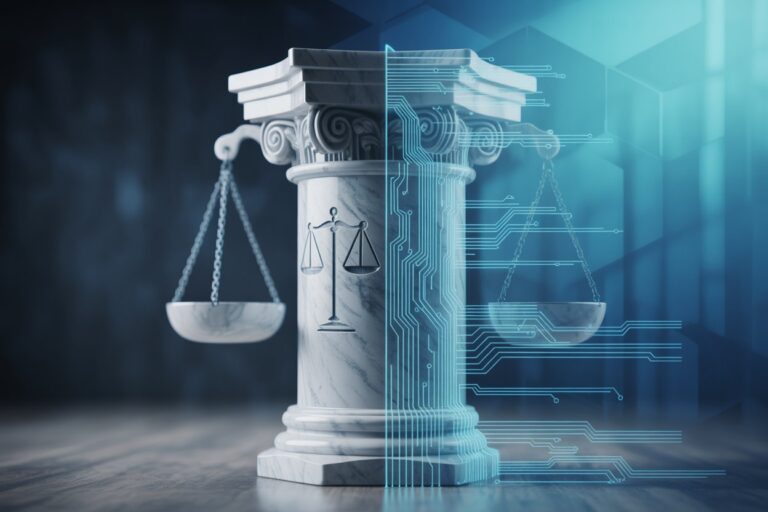Courts Tighten Standards as AI Errors Threaten Judicial Integrity
Judges are intensifying their response to AI-generated errors in legal filings. After two years of mounting sanctions, courts have moved beyond monetary fines to attorney disqualification, citing threats to the integrity of the judicial system. The shift signals a fundamental recognition: AI tools can predict persuasive language, but they cannot perform the causal reasoning that legal analysis requires.
The Meaning of Intent in Law
Intent is one of the oldest organizing principles in the legal system. Criminal law distinguishes knowing acts from negligent ones, while tort law evaluates foreseeability and purpose. Contract enforcement depends on whether parties intended to create binding obligations, and fraud claims often turn on whether a misstatement reflects deliberate deception.
These doctrines require an understanding of human mental states. Courts reconstruct motive through evidence, testimony, and context. The analysis is causal rather than statistical, which places it far from the pattern recognition that drives modern generative models.
Prediction Without Understanding
Large language models operate by predicting the next most probable token based on training data. They do not hold beliefs, form goals, or evaluate consequences. Their outputs can appear reasoned because they draw from vast bodies of human writing, including judicial opinions, statutes, and legal commentary.
Researchers at leading academic institutions have published multiple studies showing that LLMs can emulate legal logic while missing the internal causal structures necessary for reasoning. When a model hallucinates legal authority or confuses procedural standards, the underlying cause is predictive patterning, not flawed intent.
The Risks of Fluency
AI systems produce arguments that sound authoritative, which can lead practitioners to infer understanding where none exists. The Mata v. Avianca sanctions in 2023 demonstrated how quickly confidence in machine-generated text can collapse once fabricated citations are uncovered. The court emphasized that lawyers remain responsible for verifying authority, regardless of how polished a draft appears.
Fluency can also disguise a lack of element-level comprehension. A model may correctly describe a claim’s elements while misunderstanding their relationship to the facts. These limitations shift the burden back to human reviewers, who must distinguish stylistic coherence from legal correctness.
When Professional Judgment Cannot Be Delegated
The American Bar Association’s Formal Opinion 512 requires lawyers to supervise AI outputs, independently verify authority, and maintain documentation of human review. These duties reflect a recognition that AI tools cannot reliably evaluate facts, weigh competing interpretations, or understand client objectives.
Several state bars have issued parallel guidance emphasizing verification and competence. The New York City Bar Association warns that attorneys must understand AI limitations before deployment. The California State Bar emphasizes that AI cannot replace core legal analysis and cautions against inputting confidential information into unsecured systems. Florida and Colorado advisories treat AI tools as extensions of lawyer oversight obligations and warn that delegation of judgment may breach ethical duties.
Regulatory Pressure on Reasoning Claims
Regulators have begun scrutinizing representations about AI capability. The Federal Trade Commission warns that claims about how an AI model reasons, understands, or analyzes must be supported by evidence. The agency has made clear that overstating or mischaracterizing AI function can constitute an unfair or deceptive act under Section 5 of the FTC Act.
Federal guidance is complemented by transparency standards emerging at the agency level. The Office of Management and Budget’s M-24-10 memorandum requires federal agencies to use AI systems that can demonstrate reliability, transparency, and human oversight. This requirement intersects directly with claims about reasoning, which must withstand compliance review.
State Laws Target AI Reasoning Claims
Colorado’s SB 24-205 sets a high bar for documenting the logic, risks, and training data underlying high-risk AI systems beginning in 2026. Developers and deployers must maintain impact assessments and explain system behavior to regulators upon request.
New York City’s Local Law 144 extends similar transparency demands to automated employment decision tools. Annual audits must test for disparate impact and document the factors influencing system outputs. These standards reflect growing expectations for verifiable explanation rather than assumptions of reasoning.
Global Standards for AI Accountability
The European Union’s AI Act establishes explicit requirements for documentation, testing, and transparency for high-risk AI systems. Providers must maintain detailed technical records, risk management files, and plain-language summaries explaining how a system reaches determinations.
The Council of Europe’s Framework Convention on Artificial Intelligence emphasizes accountability, oversight, and safeguards against misuse. The United Kingdom’s Solicitors Regulation Authority publishes ongoing guidance advising legal practitioners to ensure that AI outputs do not replace professional judgment. Across these regimes, reasoning is treated as a human responsibility, not a machine capability.
Courts Respond to AI in Filings and Evidence
Several federal courts have implemented standing orders requiring lawyers to certify that AI-generated text has been reviewed for accuracy. Judges in the Northern District of Texas and Northern District of Illinois highlight the need for human verification and warn that AI cannot be treated as an authoritative researcher.
The Johnson v. Dunn case in the Northern District of Alabama, decided in July 2025, marked a significant escalation in judicial response to AI hallucinations. The court disqualified three attorneys from Butler Snow LLP from further participation in the case after they submitted motions containing fabricated citations generated by ChatGPT. Unlike earlier sanctions that imposed fines, the court determined that monetary penalties had proven insufficient as deterrents and that the integrity of the judicial system required stronger accountability measures.
Cases involving algorithmic risk assessment tools reinforce the caution. In State v. Loomis, the Wisconsin Supreme Court allowed a proprietary risk score during sentencing but warned that opacity prevented courts from treating it as an explanation. The case remains influential when courts evaluate automated reasoning claims.
Why Reasoning Matters in AI-Assisted Practice
Legal arguments require understanding the relationship between facts, law, and context. AI systems can restate elements of a cause of action while missing the underlying logic that connects them. A tool may describe the standard for summary judgment while failing to apply that standard to a particular record.
These gaps create difficult questions for malpractice carriers, courts, and ethics regulators. If a model produces text that appears reasoned but is logically unsound, responsibility falls on the lawyer to catch the error. Reasoning remains a human obligation even when drafting is automated.
Verification and Documentation as Safeguards
Law firms can mitigate risk through structured verification processes. Human review logs, audit trails, and approved-tool lists help ensure that AI outputs are checked for accuracy. These practices align with professional responsibility rules and support defensible workflows.
Vendor contracts should address model behavior, training data sources, retrieval methods, and error rates. Firms should request documentation that clarifies how systems generate outputs and what limitations exist. Better documentation can reduce misinterpretation and improve reliability.
The Future of AI Reasoning in Legal Work
Research in structured reasoning, retrieval augmentation, and symbolic hybrid models aims to improve the reliability of automated legal analysis. These approaches seek to balance statistical prediction with rule-based logic. Their development may shape future regulatory expectations and professional standards.
For now, reasoning remains a human responsibility. The most reliable legal work will combine machine efficiency with human judgment and context. Firms that adopt clear verification policies will be better prepared as regulatory standards evolve.
Sources
- American Bar Association: “Formal Opinion 512 on Generative AI Tools” (July 29, 2024)
- Bloomberg Law: “AI Standing Orders Proliferate as Federal Courts Forge Own Paths” (Nov. 8, 2023)
- California State Bar: “Practical Guidance for the Use of Generative AI in the Practice of Law” (2023)
- Colorado General Assembly: SB 24-205 “Artificial Intelligence Act” (2024)
- Council of Europe: “Framework Convention on Artificial Intelligence and Human Rights, Democracy and the Rule of Law” (May 2024)
- European Union: Regulation (EU) 2024/1689 “Artificial Intelligence Act” (June 2024)
- Federal Trade Commission Act, Section 5 (15 U.S.C. §45)
- EDRM: “When AI Policies Fail: The AI Sanctions in Johnson v. Dunn” (July 2025)
- Justia: State v. Loomis, Wisconsin Supreme Court (2016)
- Justia: Mata v. Avianca, S.D.N.Y. (2023)
- New York City Bar Association: “Formal Opinion 2024-5 on Generative AI in the Practice of Law” (Oct. 2024)
- New York City: Local Law 144 “Automated Employment Decision Tools” (2023)
- UK Solicitors Regulation Authority: “Artificial Intelligence in the Legal Market” (2021)
- White House: Office of Management and Budget: Memorandum M-24-10 “Advancing Governance, Innovation, and Risk Management for Agency Use of Artificial Intelligence” (March 28, 2024)
This article was prepared for educational and informational purposes only. It does not constitute legal advice and should not be relied upon as such. All cases, statutes, and sources cited are publicly available through official publications and reputable outlets. Readers should consult professional counsel for specific legal or compliance questions related to AI use.
See also: Judges Grapple with Algorithms That Test the First Amendment

Jon Dykstra, LL.B., MBA, is a legal AI strategist and founder of Jurvantis.ai. He is a former practicing attorney who specializes in researching and writing about AI in law and its implementation for law firms. He helps lawyers navigate the rapid evolution of artificial intelligence in legal practice through essays, tool evaluation, strategic consulting, and full-scale A-to-Z custom implementation.







